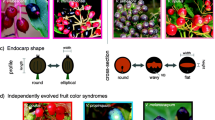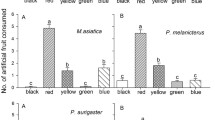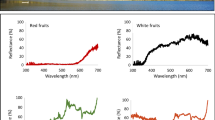Summary
We examined the selective basis of fruit color, a trait assumed to affect the attractiveness of fruits to avian dispersal agents, inRhagodia parabolica in Victoria, Australia. The fleshy fruits ofR. parabolica are highly polymorphic in color; individual plants may bear red, white, or yellow fruits, or some combination of these. Red color is produced by betacyanins, yellow by betaxanthins, and white by some other flavonoid compounds. Red is the most common color, white less common, and yellow is relatively rare; red and white is the most common color combination. Fruits of these color-morphs do not differ in maximum size, weight, pulp-seed ratio, water content, or content of major nutrients (sugars, N, and lipids). The most common avian consumer,Zosterops lateralis, foraged at random on the color-morphs, although all fruit-eaters, collectively, slightly favored white fruits. Weekly fruit removal rates were equivalent for all four morphs. Seeds from color-morphs differed in seed germination behavior: seeds from red fruits germinated faster than seeds from yellow fruits, and seeds from white fruits showed the greatest response to passage throughZ. lateralis guts. Lack of strong foraging preferences by birds and the different germination behaviors may contribute to the maintenance of the color polymorphism.
Similar content being viewed by others
References
Aalders, L. E. and Hall, I. V. (1962) The inheritance of white fruit in the velvet-leaf blueberry,Vaccinium myrtilloides Michx.Can. J. Genet. Cytol. 4, 90–1.
Costermans, L. F. (1983)Nature Trees and Shrubs of South-eastern Australia, Rigby, Adelaide, Australia.
Darwin, C. (1859)The Origin of the Species, Murray, London. (Mentor edition, 1958, p. 186.)
Davidson, D. W. and Morton, S. R. (1984) Dispersal adaptations of someAcacia species in the Australia arid zone.Ecology 65, 1038–51.
Ewart, A. J. (1930)Flora of Australia. Govt Printer, Melbourne, Australia.
Forde, N. (1985) Nectar and fruit feeding birds. InThe Ecology of South Australia's Forests and Woodlands (ed. H. R. Wallace), Govt Printer, Adelaide, Australia, pp. 154–64.
Forde, N. (1986) Relationships between birds and fruits in temperate Australia. InThe Dynamic Partnership (eds H. A. Ford and D. C. Paton), Govt Printer, Adelaide, Australia, pp. 42–58.
Gautier-Hion, A., Duplantier, J. M., Quris, R., Feer, F., Sourd, C., Decoux, J. P., Dubost, G., Emmons, L., Erard, C., Hecketsweiler, P., Moungazi, A., Roussilhon, C. and Thiollay, J. M. (1985) Fruit characters as a basis of fruit choice and seed dispersal in a tropical forest vertebrate community.Oecologia 65, 324–37.
Goodwin, T. W. and Goad, L. J. (1970). InThe Biochemistry of Fruits and Their Products (ed. A. C. Hulme), Vol. 1, Academic Press, NY, USA, pp. 305–68.
Hall, I. V. and Aalders, L. E. (1963) Two-factor inheritances of white fruit in the common lowbush blueberry,Vaccinium angustifolium Ait.Can. J. Genet. Cytol. 5, 371–3.
Janson, C. (1983) Adaptations of fruit morphology to dispersal agents in a neotropical forest.Science 219, 187–9.
Janson, C. (1987) Bird consumption of bicolored fruit displays.Amer. Natur. 130, 788–92.
Kevan, P. G. (1983) Floral colors through the insect eye: what they are and what they mean. InHandbook of Experimental Pollination Biology (eds. (C. E. Jones and R. J. Little). Van Nostrand Reinhold, NY, USA. pp. 3–30.
Kilmer, L. M. (1975) Betalain, the red beet pigment, as an antifungal agent.Bot. Soc. Amer. Abstr. p. 36.
Knight, R. S. and Siegfried, W. R. (1983), Inter-relationships between type, size and colour of fruits and dispersal in South African trees.Oecologia 56, 405–12.
Lea, A. M. and Gray, J. T. (1935–6) The food of Australian birds.Emu 34, 275–92.
Mabry, T. J. and Dreiding, A. S. (1968) The betalains.Rec. Adv. Phytochem. 1, 145–60.
Mabry, T. J., Markham, K. R. and Thomas, M. B. (1970)The Systematic Identification of Flavonoids, Springer-Verlag, NY, USA.
Markham, K. R. and Mabry, T. J. (1975) Ultraviolet-visible and proton magnetic resonance spectroscopy of flavonoids. InThe Flavonoids (eds J. B. Harborne, T. J. Mabry and H. Mabry) Chapman and Hall, London, UK, pp. 45–77.
McPherson, J. M. (1988) Preferences of cedar waxwings in the laboratory for fruit species colour and size: a comparison with field observations.Anim. Behav. 36, 961–9.
O'Dowd, D. J. and Gill, A. M. (1984). Predator satiation and site alteration following fire: mass reproduction of alpine ash (Eucalyptus delegatensis) in southeastern Australia.Ecology 65, 1052–66.
Ootani, S. and Hagiwara, T. (1969). Inheritance of flower colors and related chymochromic pigments in F1 hybrids of common portulaca,Portulaca grandiflora.Japan. J. Genet. 44, 65–79.
Piatelli, M. (1976) Betalains. InChemistry and Biochemistry of Plant Pigments (ed. T. W. Goodwin) Academic Press, London, UK, pp. 560–96.
Porra, R. J. and Stumpf, P. K. (1976). Lipid biosynthesis in developing and germinating soybean cotyledons.Archiv. Biochem. Biophys. 176, 53–62.
Ridley, H. N. (1930)The Dispersal of Plants Around the World. Reeve, Ashford, Kent, UK.
SPSSx (1986)User's Guide, SPSS, McGraw-Hill, NY, USA.
Stanley, T. D. and Ross, E. M. (1983)Flora of South-eastern Queensland, Vol. 1, Queensland Dept of Primary Ministries Misc. Publ. 81020.
Swain, T. (1976) Nature and properties of flavonoids. InChemistry and Biochemistry of Plant Pigments (ed. T. W. Goodwin) Academic Press, London, UK, pp. 425–63.
Tester, M., Paton, D. C., Reid, N. and Lange, R. T. (1987). Seed dispersal by birds and densities of shrubs under trees in arid South AustraliaTrans. Roy. Soc. S.A. 111, 1–5.
Turcek, F. J. (1963) Color preference in fruit- and seed-eating birds.Proc. Intern. Ornith. Cong. 13, 285–92.
Willson, M. F. (1983a) Natural history ofActaea rubra: fruit dimorphism and fruit/seed predation.Bull. Torrey Bot. Club 110, 298–203.
Willson, M. F. (1983b)Plant Reporduction Ecology, Wiley-Interscience, NY, USA.
Willson, M. F. (1986) Avian frugivory and seed dispersal in eastern North America.Current Ornithology,3, 223–79.
Willson, M. F. and Crome, F. H. J. Patterns of seed rain at the edge of a tropical Queensland rain forest.J. Trop. Ecol. in press.
Willson, M. F., Irvine, A. K. and Walsh, N. G. Vertebrate dispersal syndromes in some Australian and New Zealand plant communities, with some geographic comparisons.Biotropica in press.
Willson, M. F. and Melampy, M. N. (1983) The effect of bicolored fruit displays on fruit removal by avian frugivores.Oikos 41, 27–31.
Wilson, P. G. (1984) Chenopodiaceae.Flora of Australia 4, 81–317. Australian Govt Publishing Service, Canberra.
Wohlpart, A. and Mabry, T. J. (1968) The distribution and phylogenetic significance of the betalains with respect to the Centrospermae.Taxon 17, 148–52.
Author information
Authors and Affiliations
Rights and permissions
About this article
Cite this article
Willson, M.F., O'Dowd, D.J. Fruit color polymorphism in a bird-dispersed shrub (Rhagodia parabolica) in Australia. Evol Ecol 3, 40–50 (1989). https://doi.org/10.1007/BF02147930
Issue Date:
DOI: https://doi.org/10.1007/BF02147930




